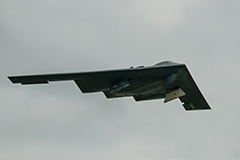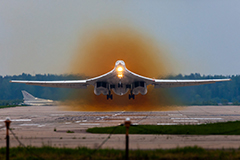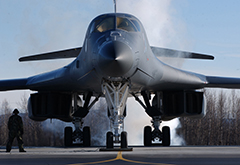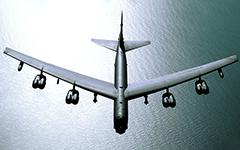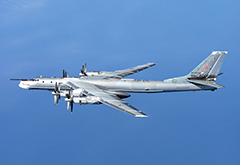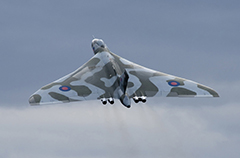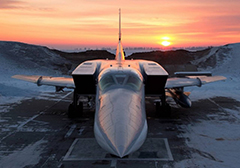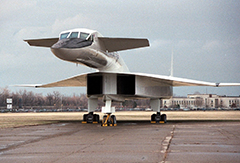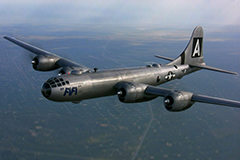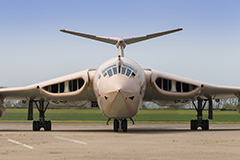1. B-2 Stealth Bomber:
The Northrop (later Northrop Grumman) B-2 Spirit, also known as the Stealth Bomber, is an American heavy penetration strategic bomber, featuring low observable stealth technology designed for penetrating dense anti-aircraft defenses; it is a flying wing design with a crew of two. The bomber can deploy both conventional and thermonuclear weapons, such as eighty 500 lb (230 kg)-class (Mk 82) JDAM Global Positioning System-guided bombs, or sixteen 2,400 lb (1,100 kg) B83 nuclear bombs. The B-2 is the only acknowledged aircraft that can carry large air-to-surface standoff weapons in a stealth configuration. More details
2. Tupolev Tu-160 Bomber:
The Tupolev Tu-160 (White Swan) is a supersonic, variable-sweep wing heavy strategic bomber designed by the Tupolev Design Bureau in the Soviet Union. It is the largest and heaviest Mach 2+ supersonic aircraft ever built and second only to the comparable XB-70 Valkyrie in overall length. It is the largest and heaviest combat aircraft, the fastest bomber now in use and the largest and heaviest variable-sweep wing airplane ever flown. Entering service in 1987, the Tu-160 was the last strategic bomber designed for the Soviet Union. As of 2016, the Russian Air Force, Long Range Aviation branch has at least 16 aircraft in service. More details
3. Rockwell B-1 Lancer Bomber:
The Rockwell B-1 Lancer is a supersonic variable-sweep wing, heavy bomber used by the United States Air Force. It is commonly called the "Bone" (from "B-One"). It is one of three strategic bombers in the U.S. Air Force fleet as of 2018, the other two being the B-2 Spirit and the B-52 Stratofortress. The B-1 was first envisioned in the 1960s as a platform that would combine the Mach 2 speed of the B-58 Hustler with the range and payload of the B-52, and would ultimately replace both bombers. After a long series of studies, Rockwell International (now part of Boeing) won the design contest for what emerged as the B-1A. More details
4. B-52 Stratofortress Bomber:
The Boeing B-52 Stratofortress is an American long-range, subsonic, jet-powered strategic bomber. The B-52 was designed and built by Boeing, which has continued to provide support and upgrades. It has been operated by the United States Air Force (USAF) since the 1950s. The bomber is capable of carrying up to 70,000 pounds (32,000 kg) of weapons, and has a typical combat range of more than 8,800 miles (14,080 km) without aerial refueling. Beginning with the successful contract bid in June 1946, the B-52 design evolved from a straight wing aircraft powered by six turboprop engines to the final prototype YB-52 with eight turbojet engines and swept wings. More details
5. Tupolev Tu-95 Bomber:
The Tupolev Tu-95 (The Bear) is a large, four-engine turboprop-powered strategic bomber and missile platform. First flown in 1952, the Tu-95 entered service with the Soviet Union in 1956 and is expected to serve the Russian Air Force until at least 2040. A development of the bomber for maritime patrol is designated Tu-142, while a passenger airliner derivative was called Tu-114. The aircraft has four Kuznetsov NK-12 engines with contra-rotating propellers. It is the only propeller-powered strategic bomber still in operational use today. The Tupolev Tu-95 bomber is one of the loudest military aircraft, particularly because the tips of the propeller blades move faster than the speed of sound. More details
6. Avro Vulcan Bomber:
The Avro Vulcan is a jet-powered tailless delta wing high-altitude strategic bomber, which was operated by the Royal Air Force (RAF) from 1956 until 1984. Aircraft manufacturer A.V. Roe and Company (Avro) designed the Vulcan in response to Specification B.35/46. Of the three V bombers produced, the Vulcan was considered the most technically advanced and hence the riskiest option. Several scale aircraft, designated Avro 707, were produced to test and refine the delta wing design principles. The Vulcan B.1 was first delivered to the RAF in 1956; deliveries of the improved Vulcan B.2 started in 1960. More details
7. Tupolev Tu-22M Bomber:
The Tupolev Tu-22M is a supersonic, variable-sweep wing, long-range strategic and maritime strike bomber developed by the Tupolev Design Bureau. According to some sources, the bomber was believed to be designated Tu-26 at one time. During the Cold War, the Tu-22M was operated by the Soviet Air Forces (VVS) in a strategic bombing role, and by the Soviet Naval Aviation (Aviacija Vojenno-Morskogo Flota, AVMF) in a long-range maritime anti-shipping role. Significant numbers remain in service with the Russian Air Force, and as of 2014 more than 100 Tu-22Ms are in use. More details
8. XB-70 Valkyrie Bomber:
The North American Aviation XB-70 Valkyrie was the prototype version of the planned B-70 nuclear-armed, deep-penetration strategic bomber for the United States Air Force Strategic Air Command. Designed in the late 1950s by North American Aviation (NAA), the six-engined Valkyrie was capable of cruising for thousands of miles at Mach 3+ while flying at 70,000 feet (21,000 m). At these speeds, it was expected that the B-70 would be almost immune to interceptor aircraft, the only effective weapon against bomber aircraft at the time. More details
9. B-29 Superfortress Bomber:
The Boeing B-29 Superfortress is a four-engine propeller-driven heavy bomber designed by Boeing and flown primarily by the United States during World War II and the Korean War. Named in allusion to its predecessor, the B-17 Flying Fortress, the Superfortress was designed for high-altitude strategic bombing but also excelled in low-altitude night incendiary bombing. B-29s also dropped the atomic bombs on Hiroshima and Nagasaki which led to the end of World War II. One of the largest aircraft of World War II, the B-29 had state-of-the-art technology, including a pressurized cabin; dual-wheeled, tricycle landing gear; and an analog computer-controlled fire-control system. More details
10. Handley Page Victor Bomber:
The Handley Page Victor is a British jet-powered strategic bomber, developed and produced by Handley Page, which served during the Cold War. It was the third and final V-bomber to be operated by the Royal Air Force (RAF), the other two being the Avro Vulcan and the Vickers Valiant. The Victor had been developed as part of the United Kingdom's airborne nuclear deterrent. In 1968, it was retired from the nuclear mission following the discovery of fatigue cracks, which had been exacerbated by the RAF's adoption of a low-altitude flight profile to avoid interception. More details

